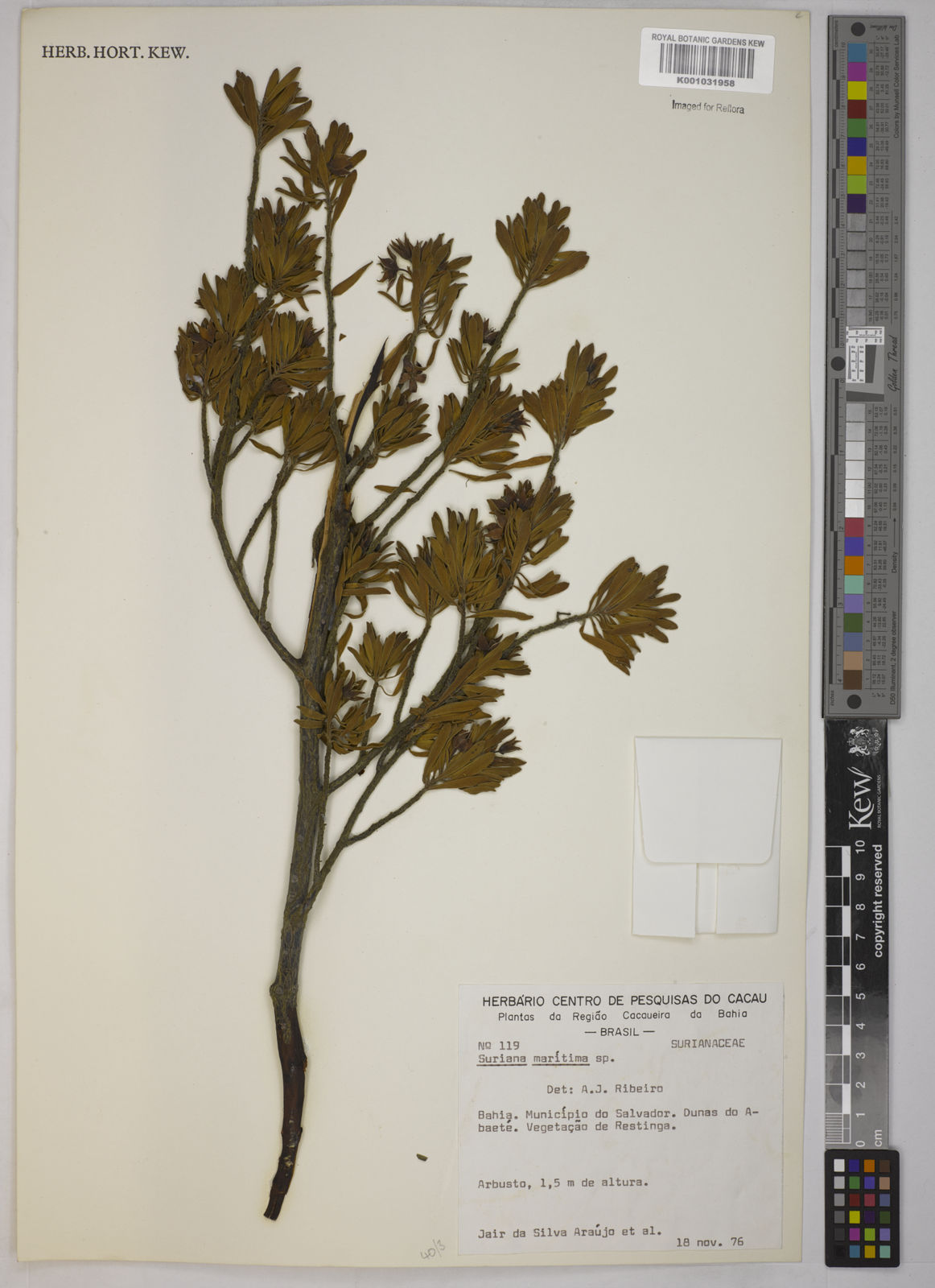Family: Surianaceae
Author: L.
Bibliography: Sp. Pl.: 284 (1753)
Year: 1753
Status: accepted
Rank: species
Genus: Suriana
Vegetable: False
Observations: SE. Kenya to Mozambique and Pacific, Florida, S. Mexico to Trop. America
Description
Bay-cedar, scientifically known as Suriana maritima, is a notable species of flowering plant belonging to the Surianaceae family. Documented as early as 1753 in “Species Plantarum” by the renowned botanist Carl Linnaeus, the Bay-cedar has since been recognized for its widespread distribution and ecological importance.
This resilient plant is predominantly found along coastal regions, spanning from southeastern Kenya down to Mozambique on the African continent. Its distribution extends across the Pacific, gracing the beaches of Florida, southern Mexico, and various locales throughout tropical America. The Bay-cedar is well-adapted to thrive in its seaside habitats, typically characterized by sandy soils and saline conditions.
Suriana maritima features a compact, evergreen shrub morphology, usually growing to a height of about 1 to 4 meters. Its leaves are small, narrow, and covered with a fine pubescence, lending a distinctive, silvery-green appearance that helps reduce water loss in its often arid, sun-drenched environment. The plant’s flowers are bright yellow and arranged in small clusters, contributing to its aesthetic appeal. These blossoms not only attract attention but also play a crucial role in the coastal ecosystems by attracting various pollinators.
One of the significant ecological contributions of the Bay-cedar includes its ability to stabilize sand dunes and prevent coastal erosion. The plant’s extensive root system binds the sand, thereby enhancing the structural integrity of the shoreline against the forces of wind and water. Additionally, it provides shelter and food for a myriad of wildlife species, forming part of the dynamic and interconnected coastal habitat.
The Bay-cedar has also been utilized in traditional medicine and local practices by indigenous communities throughout its range. Parts of the plant are used for their purported medicinal properties, including treatments for a variety of ailments. However, such uses should be approached with caution and under guidance, owing to the need for scientific validation of its efficacy and safety.
In conclusion, Suriana maritima, or Bay-cedar, is a plant of considerable environmental and cultural significance. Its presence along various tropical and subtropical coastlines underscores its adaptability and importance in fostering healthy coastal ecosystems. Through both its ecological functions and traditional uses, the Bay-cedar remains an invaluable component of its native landscapes.
Common Names
Eng: bay cedar, bay-cedar, baycedar, guitar, tassel plant
Por: ciprestinho
En: Bay-cedar, Bay cedar, Baycedar, Guitar, Tassel plant
Pt: Ciprestinho
Synonyms
Distribution
- Aldabra (native)
- Andaman Is. (native)
- Aruba (native)
- Belize (native)
- Bermuda (native)
- Brazil Northeast (native)
- Caroline Is. (native)
- Cayman Is. (native)
- Chagos Archipelago (native)
- Cocos (Keeling) Is. (native)
- Colombia (native)
- Cook Is. (native)
- Cuba (native)
- Dominican Republic (native)
- Fiji (native)
- Florida (native)
- Gilbert Is. (native)
- Haiti (native)
- Honduras (native)
- India (native)
- Jamaica (native)
- Kenya (native)
- Laccadive Is. (native)
- Leeward Is. (native)
- Lesser Sunda Is. (native)
- Line Is. (native)
- Madagascar (native)
- Maldives (native)
- Maluku (native)
- Marianas (native)
- Marshall Is. (native)
- Mauritius (native)
- Mexico Gulf (native)
- Mexico Southeast (native)
- Mozambique (native)
- Mozambique Channel I (native)
- Nauru (native)
- Netherlands Antilles (native)
- New Guinea (native)
- Nicaragua (native)
- Nicobar Is. (native)
- Pakistan (native)
- Panamá (native)
- Philippines (native)
- Phoenix Is. (native)
- Pitcairn Is. (native)
- Puerto Rico (native)
- Rodrigues (native)
- Samoa (native)
- Seychelles (native)
- Society Is. (native)
- South China Sea (native)
- Southwest Caribbean (native)
- Sri Lanka (native)
- Taiwan (native)
- Tanzania (native)
- Tokelau-Manihiki (native)
- Tonga (native)
- Tuamotu (native)
- Tubuai Is. (native)
- Turks-Caicos Is. (native)
- Tuvalu (native)
- Venezuela (native)
- Venezuelan Antilles (native)
- Vietnam (native)
- Wallis-Futuna Is. (native)
- Western Australia (native)
- Windward Is. (native)
Additional Images
Leaf
Taken Apr 30, 2019 by Francis Boermans (cc-by-sa)
Taken Jul 4, 2016 by Hugo SANTACREU (cc-by-sa)
Taken Jul 6, 2019 by philomène passa (cc-by-sa)
Taken Sep 23, 2022 by sebahattin eray (cc-by-sa)
Taken Jul 8, 2021 by Gonoo Dev (cc-by-sa)
Flower
Taken Jul 4, 2016 by Hugo SANTACREU (cc-by-sa)
Taken Oct 28, 2020 by claude Marodon (cc-by-sa)
Taken Jan 1, 1900 by EOL − Carrington, S. (cc-by-nc-sa)
Taken Jul 25, 2020 by BrianGabriel (cc-by-sa)
Taken Jul 6, 2019 by philomène passa (cc-by-sa)
Habit
Taken Jan 1, 1970 by Endemia – Julien Barrault (cc-by-nc)
Taken Nov 27, 2022 by Marzanna Bug (cc-by-sa)
Taken Dec 26, 2020 by Coordination Endemia (cc-by-sa)
Taken Oct 8, 2016 by laurence comte (cc-by-sa)
Taken Jan 1, 1900 by EOL − Acevedo, P. (cc-by-nc-sa)

© copyright of the Board of Trustees of the Royal Botanic Gardens, Kew.

© copyright of the Board of Trustees of the Royal Botanic Gardens, Kew.
Fruit
Taken Jan 1, 1900 by EOL − Acevedo, P. (cc-by-nc-sa)
Taken Dec 10, 2007 by Tela Botanica − Liliane Roubaudi (cc-by-sa)
Taken Jan 1, 1900 by EOL − Howard, R.A. (cc-by-nc-sa)
Taken Oct 8, 2016 by laurence comte (cc-by-sa)
Taken Jul 23, 2022 by laurent00031 (cc-by-sa)
Bark
Taken Jan 1, 1900 by EOL − Howard, R.A. (cc-by-nc-sa)
Taken Apr 30, 2019 by Francis Boermans (cc-by-sa)
Taken Jul 4, 2016 by Hugo SANTACREU (cc-by-sa)
Sources
- WFO (No URL)
- IPNI (No URL)
- GBIF (https://www.gbif.org/species/2986073)
- POWO (http://powo.science.kew.org/taxon/urn:lsid:ipni.org:names:814158-1)
- PlantNet (https://identify.plantnet.org/species/the-plant-list/Suriana maritima L.)
Specifications
Growth habit>: Shrub, Tree























